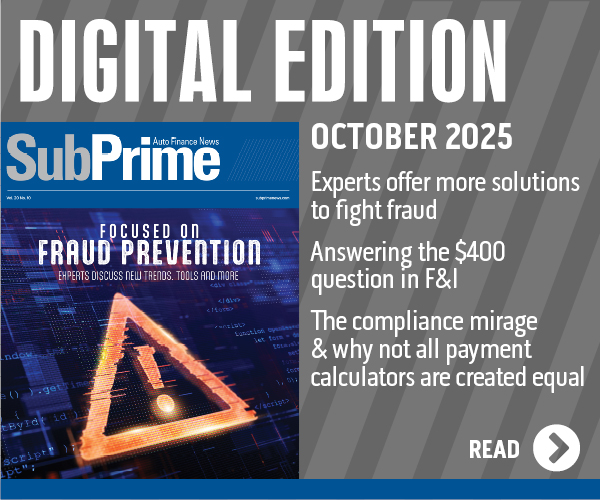Experian Webinar Takes In-Depth Look into Auto Finance Market Trends
By subscribing, you agree to receive communications from Auto Remarketing and our partners in accordance with our Privacy Policy. We may share your information with select partners and sponsors who may contact you about their products and services. You may unsubscribe at any time.
SCHAUMBURG, Ill. — On Wednesday, Experian Automotive reported that rising average credit scores on both new and used loans, a downswing in delinquency rate growth and lower at-risk loan values have been pointing toward stabilization in the market.
More specifically, Melinda Zabritski, director of automotive credit for Experian Automotive, explained that average credit scores for both new- and used-vehicle loan originations climbed in the third quarter of 2009.
In fact, the average credit score for a new-vehicle loan reached 775 in the third quarter, up from 762 in the third quarter of 2008, while the average credit score for a used-vehicle loan was 684 in the third quarter, up from 670 in the third quarter of 2008.
"Lenders are making fewer risky loans today than they did just two years ago," Zabritski indicated. "The prime and super-prime segments of the market accounted for 66 percent of new originations in the third quarter of 2009, up from 56.6 percent in 2007. The deep-subprime and subprime segments of the market accounted for 28.92 percent of the market in the third quarter of 2007 and dropped to 21.84 percent of the market in the third quarter of 2009."
She went on to say, "Much of today's rising delinquency rate relates to loan practices from 2007. Many more risky loans were made during this time and are now delinquent. By moving more of their loan portfolios into lower-risk tiers, lending institutions are doing a better job of mitigating risk, which may lead to lower delinquency rates in the future."
30-Day Delinquency Rates
Subscribe to Auto Remarketing to stay informed and stay ahead.
By subscribing, you agree to receive communications from Auto Remarketing and our partners in accordance with our Privacy Policy. We may share your information with select partners and sponsors who may contact you about their products and services. You may unsubscribe at any time.
Looking specifically at 30- and 60-day delinquency rates, Zabritski said they are still on the rise, but the rate of growth for 30-day delinquencies "appears to be slowing."
According to Experian data, 30-day delinquencies grew to 3.32 percent in the third quarter, compared with 3.14 percent in the same period of 2008.
"This is only a 5.8-percent increase, compared with a 9.5-percent increase from the third quarter of 2007 to the third quarter of 2008," Zabritski noted.
Basically, 30-day delinquencies jumped by 21.7 percent for banks, but only grew by 8.7 percent for captives and 4.5 percent for credit unions. Meanwhile, finance companies saw a decline of 0.1 percent in 30-day delinquencies.
"While higher-than-average delinquency rates are still with us and may be for some time, the fact that the rate of increase is slowing is definitely some positive news for an industry that hasn't had much as of late," Zabritski said.
"These slowing delinquency rates, along with several other trends we are now seeing, should provide some cautious optimism for the market," she added.
60-Day Delinquencies
Sixty-day delinquencies are another story. Zabritski said these are continuing to show large increases.
The 60-day delinquency rate rose from 0.84 percent to 0.95 percent, a 13.4-percent increase from the third quarter of 2008 to the same time frame of 2009.
Additionally, these delinquencies rose by 14.5 percent for banks, 29.2 percent for captive finance companies, 16.7 percent for credit unions and 15.5 percent for finance companies and other lenders.
Lender Market Share
Reviewing lender market share, Zabritski found that loan originations for new vehicles are becoming more concentrated among fewer lenders.
"The top 20 lenders accounted for 72 percent of all new-vehicle loan originations in the third quarter of 2009, compared with 64 percent in the third quarter of 2008," she highlighted.
In fact, Toyota Financial Services had the strongest market share at 11.2 percent, followed by Chase Auto Finance at 11.1 percent, GMAC at 9.1 percent and Ford Motor Credit at 7.1 percent.
Furthermore, several banks showed triple-digit gains in market share growth, including Chase Auto Finance at 129.5 percent, U.S. Bank at 113 percent, Wachovia Dealer Services (a part of Wells Fargo) at 103.1 percent and Hyundai at 103 percent, Experian discovered.
On the used-vehicle side, Zabritski said lending remains "far more fragmented." She went on to report that the top 20 lenders have 31 percent market share. This includes Wachovia Dealer Services at 5.7 percent, Chase Auto Finance at 4.5 percent, Toyota Financial Services at 3 percent and Capital One Auto Finance at 1.8 percent.
"The top share gainers by percentage growth include U.S. Bank (67.6 percent), Fifth Third Bank (64.3 percent), Chase Auto Finance (50.7 percent) and TD BankNorth (42.6 percent)," she explained.
Loan Values
Continuing on, Zabritski explained that the average loan value during the third quarter declined significantly.
For new vehicles, the average loan value was $22,712 in the third quarter, compared with $24,060 in the third quarter of 2008.
"This is due in part to Cash for Clunkers, which provided significant incentives during the third quarter of 2009 and helped drive down loan values," Zabritski indicated.
Used-vehicle loan values, meanwhile, dropped only a bit from $15,983 in the third quarter of 2008 to $15,720 in the same period of 2009.
Open Loan Balance
So how are open loans faring? According to Experian, the decline in auto loans had a big impact of total loan balance. In the third quarter of 2008, the balance was $701.5 billion, dropping 4 percent to $673.4 billion in the third quarter of 2009.
"The drop in loan value was sharpest among finance companies that do the majority of their loans to subprime and deep-subprime customers. Their total loan balance dropped 23 percent from $100 billion in the third quarter of 2008 to $77.3 billion in the third quarter of 2009," Zabritski said. "Captive finance companies also saw a drop in loan values, falling 5.4 percent from $214.2 billion in the third quarter to $202.7 billion in the third quarter of 2009."
Who were the biggest gainers? That would be credit unions, Experian found. These financial institutions grew loan balance by 3.4 percent from $147.1 billion in the third quarter of 2008 to $152.1 billion in the same time frame of 2009.
"Banks also showed a slight gain, going from $240 billion in the third quarter of 2008 to $241.1 billion in the third quarter of 2009," Zabritski noted.
In conclusion, Scott Waldron, president of Experian Automotive, pointed out, "We are seeing signs of stabilization in the automotive lending market that could spell good overall health for the auto industry in the long run.
"Lending institutions are making less risky loans right now. As some of the higher-risk loans from a few years ago come off the books, lenders will be in a much better position to serve the automotive market," he said.


